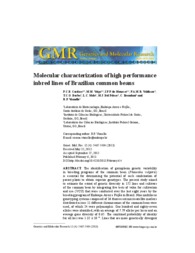Molecular characterization of high performance inbred lines of Brazilian common beans.
Molecular characterization of high performance inbred lines of Brazilian common beans.
Autoria: CARDOSO, P. C. B.; VEIGA, M. M.; MENEZES, I. P. P. de; VALDISSER, P. A. M. R.; BORBA, T. C. O.; MELO, L. C.; DEL PELOSO, M. J.; BRONDANI, C.; VIANELLO, R. P.
Resumo: The identification of germplasm genetic variability in breeding programs of the common bean (Phaseolus vulgaris) is essential for determining the potential of each combination of parent plants to obtain superior genotypes. The present study aimed to estimated the extent of genetic diversity in 172 lineages and cultivars of the common bean by integrating five tests of value for cultivation and use (VCU) that were conducted over the last eight years by the breeding program of Embrapa Arroz e Feijão in Brazil. Nine multilocus genotyping systems composed of 36 fluorescent microsatellite markers distributed across 11 different chromosomes of the common bean were used, of which 24 were polymorphic in all trials. One hundred and eighty-seven alleles were identified, with an average of 7.79 alleles per locus and an average gene diversity of 0.65. The combined probability of identity for all loci was 1.32 x 10(-16). Lineages that are more genetically divergent between the selection cycles were identified, allowing the breeding program to develop a crossbreed between elite genotypes with a low degree of genetic relatedness. HE values ranged from 0.31 to 0.63, with a large reduction in the genetic base over successive selection cycles. The test showed a significant degree of differentiation (FST = 0.159). Private alleles (26%) were identified and can be directly incorporated into the gene pool of cultivated germplasm, thereby contributing effectively to the expansion of genetic diversity in this bean-breeding program.
Ano de publicação: 2013
Tipo de publicação: Artigo de periódico
Unidade: Embrapa Arroz e Feijão
Palavras-chave: Feijão, Genetic lines, Inbred lines, Melhoramento genético, Phaseolus vulgaris, Variação genética
Observações
1 - Por padrão são exibidas publicações dos últimos 20 anos. Para encontrar publicações mais antigas, configure o filtro ano de publicação, colocando o ano a partir do qual você deseja encontrar publicações. O filtro está na coluna da esquerda na busca acima.
2 - Para ler algumas publicações da Embrapa (apenas as que estão em formato ePub), é necessário ter, no celular ou computador, um desses softwares gratuitos. Sistemas Android: Google Play Livros; IOS: iBooks; Windows e Linux: software Calibre.
Acesse outras publicações
Acesse a Base de Dados da Pesquisa Agropecuária (BDPA) para consultar o acervo completo das bibliotecas da Embrapa.

